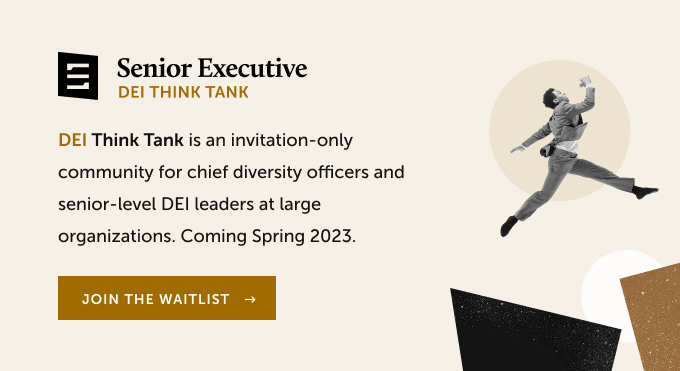You wouldn’t be the diversity, equity, and inclusion (DEI) leader you are today without the people you’ve met, the experiences you’ve gained, and the lessons you’ve learned along the way. Despite where you may go, there will be a unique set of challenges that you’ll not only be expected to concede to but conquer. Don’t sweat it; your network, skills, and abilities are coming with you.
Senior Executive DEI reporters are speaking with DEI leaders across industries to further understand the intricacies of the roles chief diversity officers play in different operating environments. If you’re considering jumping into a DEI position in tech, consider these six factors that may shape your experience.
1. Closing the diversity gap in tech, an industry that lacks racial and gender diversity.
Despite the current wave of layoffs and hiring freezes — nearly 200,000 tech employees have been laid off so far in 2023, according to Layoffs.fyi — a major issue for many tech companies remains engaging and retaining diverse talent. “The competitive landscape is there but especially from a diversity and inclusion perspective, [finding] diverse talent in tech is a challenge,” says Angelique Buster, the director of diversity, equity, and inclusion at Khoros, a customer engagement software company.
Although Khoros’ gender distribution is on par with the rest of tech, which is about 28% women, Buster says Khoros is improving its attraction and retention of diverse talent from underrepresented groups by building brand awareness. The organization’s sourcing strategy involves engaging Khoros’ employees, including its employee resource group (ERG) members, to attend conferences, lead webinars, and join organizations where they can network and attract new talent. The software company is also recruiting from Historically Black Colleges and Universities and major universities with diversity programming and organizations, such as the National Society of Black Engineers.
While Khoros is in a slow hiring period, Buster says her focus is on building internal equity. “I’m focusing on the recruiters themselves and helping them understand what a sourcing strategy would look like when we’re looking for diverse candidates, and how to create those interlinks in relationships because relationships are key, especially when you’re not one of the major [tech companies].” Buster says Khoros is also providing more training for hiring managers, such as unconscious bias training. “We’ve been planting little seeds throughout [the hiring cycle] so that folks can understand, ‘ok, now it’s time for me to hire for a certain role, and I’m well-versed in how I should interview and what I should look for in diverse talent.’”
Kevin Walters, the senior director of diversity and inclusion solutions at SilkRoad Technology and a member of the Senior Executive DEI Think Tank, adds tech companies are also falling short in retaining women. “There’s been such a focus on hiring for gender diversity but we’re finding that women especially are getting burned out,” he says, citing a McKinsey study that found 43% of women leaders are burned out compared to 31% of men at their level. This is attributed to women being overworked and under-recognized at work and a lack of flexibility as women juggle their jobs with being primary caregivers.
SilkRoad Technology, which has more male-identifying employees than women, is working to close the gap. “We have good representation at the leadership level but we want to make sure there’s parity across the board,” Walters says. He adds the management software company is conducting inclusion surveys, building training around bias, creating ERGs, and holding listening sessions to allow employees to share and listen to one another.
Walters says DEI executives need to be a part of conversations about hires and layoffs because it’s an opportunity to point to data, like exit surveys, show why people are leaving, and highlight systemic issues within an organization. “Until [tech executives] change corporate policies, then we’re not going to see change and transformation,” Walters says.
2. Getting executives to look at the nuances in your DEI metrics to make company decisions based on the underrepresented voices within your organization.
Data is at the heart of DEI. It communicates DEI leaders’ accomplishments to stakeholders, showing them all the ways their company is equitable and inclusive as well as where they can improve. It also gives employees a voice.
“Making people feel like they belong or feel included in their workplace is the baseline foundation for engagement. If you’re not listening to your employees and their needs, and you’re not diversifying your population, you’re ignoring your employee base. In which case your turnover is going to go up, your attrition is going to go up, and engagement is going to go down. That costs money.” says Amy Hull, the director of diversity, equity, and inclusion at Paycor, an online payroll software. She adds that this is an opportunity to use data to show why your organization needs to get or stay committed to DEI.
Madhavi Bhasin, the vice president of diversity, inclusion, and belonging at Okta, Inc., a cloud-based identity management system, advises, however, DEI leaders in tech to be wary of the nuances in data. “You can use the data to tell any story you want. You can say, ‘we’re promoting men and women at approximately the same rate. This is what our data shows,’” Bhasin says. “As a diversity and inclusion professional, I want to see how long the man was in the role versus the woman. Was the woman promoted from one IC (individual contributor) level to another IC level while most men are promoted to the managerial and leadership track?”
Hull compares baseline demographics — race, ethnicity, and gender identity — to an iceberg because it’s what you see at the top, but it’s what’s underneath that sank the Titanic. “You have to hold focus groups. You have to hear what employees are thinking and feeling and identify themes in [those results].” A few examples of comprehensive questions you can ask on anonymous surveys are: Do you feel included here? Do you feel like you belong here? Do you feel supported by your manager in sensitive situations?
“All of these kinds of questions can help identify underlying issues that don’t get brought to the surface because people might be afraid to say something about it,” Hull says. “It’ll give you an accurate picture of how people really feel about working [for you]… When you find that story, you figure out what your top three metrics are and you get to work.”
Bhasin emphasizes that the real data is in the nuances. As an example, Bhasin shares that if she was a manager who conducted a happiness survey and found that 80% of employees were generally happy at work, she would look at how women, Black women, and people of color answered the question. “[Those numbers] are the nuances because if you’re looking at the overall number, you’re still looking at the dominant voice.”
She further highlights why you should look at data from underrepresented voices within your organization, adding: “If you’re solving for the most marginalized, then everybody is going to have an inclusive experience. But if you’re solving for the dominant number…if you’re not intentionally inclusive, then you end up being exclusive.”
3. Engineering teams at tech companies don’t necessarily reflect the customer base, which means you have to actively promote diversity of thought in product development.
Not only do employees want to work with companies that prioritize DEI, but so do clients. “I can’t tell you how many times I hear from salespeople, from marketing, from people outside of the business, that customers these days, many of them are not willing to do business with a company that doesn’t have diversity, equity, and inclusion as a priority. They won’t even talk to you,” Hull says. “I’ve literally been in situations where sellers [say] they’re not going to engage with us unless we tell them exactly what we’re doing.”
Hull says this unfortunately forces her to monetize her DEI efforts. She adds, “In our industry, everything is money and technology moves way too fast. You have to be able to align your business case to the overall plan for the company and show how DEI helps you get there and improves revenue.”
As the chief diversity and public affairs officer at GoGuardian, a digital learning tool, Dionna Smith supports client-focused digital learning programs for more than 27 million K-12 students across the U.S.
“I work closely with our chief marketing officer and there’s very much an inclusive lens on our external marketing and looking at how we can do things like co-create,” Smith says. “One of the things we’ve been looking at closely is how we co-create using our internal folks or ERGs and also external partnerships that can help ensure we’re getting everyone’s voices.”
Smith adds GoGuardian also works with students, allowing them to test their product and offer crucial feedback, such as offering different hairstyles, hair colors, and skin colors for their avatars. Smith says it’s a no-brainer to incorporate that kind of feedback into GoGuardian’s product.
“About 52% of students in public education identify as [a race] other than white… No company that’s focused on a consumer base where 50% or more of the folks identify a certain way would not feel like they need to ensure that their needs are being met,” Smith says. “I’ve made it a priority to drive how the demographics of the country and the demographics of our customers should be driving where we spend our money and what we pay attention to.”
GoGuardian has a group dedicated to equity research and development, which offers insight to products and testing, and Smith emphasizes the importance of co-creation between the product, engineering, and DEI teams. “Ideation and testing are two places that are super important and tend to not have diverse views, so we really focus on them and make sure we’re co-creating in those areas.”
4. Financial challenges in the tech industry have led to a lack of executive commitment to DEI jobs.
In the three years since George Floyd’s murder ignited protests across the nation against systemic racism, many tech companies have gone from doubling down on DEI to dramatically cutting their budgets and laying off thousands of employees, mostly from the human resources and DEI teams. At Twitter, just two of 30 DEI employees remain. Lyft’s team has a similar story.
Walters says many tech company leaders still believe they have time to put diversity, equity, inclusion, and belonging initiatives on hold while they focus on their products and revenue. “In these turbulent times, [tech companies are saying] … ‘We’ll catch up to making sure that we have a diverse and inclusive environment,’ and that’s not how it works. That strategy is not only causing them to lag further behind, but it’s leaving them out of the game,” Walters says.
Companies that fail to take accountability are not only losing out on a valuable market but a profitable one — the diversity and inclusion global market is expected to increase from $9.3 billion in 2022 to $25.4 billion by 2026, according to a report from Research and Markets. Through survey results from 120 major companies, the report also found that diverse companies earn 2.5 times higher cash flow per employee and inclusive teams were 35% more productive.
The companies that will see these types of results are the ones that remain committed to the cause. To ensure DEI is “a lens employees work through” at Unqork, a no-code development software program, vice president of global inclusion Netta Jenkins asks for quantifiable DEI achievements during the interview process.
“We ask [candidates], ‘How did you implement DEI on your team? How did you push the needle forward? What was representation across your team?’ and if they can’t speak to it, then that’s an issue,” Jenkins, who is also a Senior Executive DEI Think Tank member, says. “We ensure that folks coming into the organization are dedicated to [DEI] efforts because it’s embedded in the fabric of what we do.”
Bhasin says embedding and improving DEI in HR systems and processes is crucial to reaching DEI goals. “The more power I have across my people systems, the more equitable my people systems will be. The more equitable these systems are, the more people will experience inclusion and belonging.”
Holding stakeholders accountable is about ensuring processes and policies are changing. Bhasin adds that it’s not just about telling employees to ask managers for what they want and reassuring them it will be granted. “Is it a codified policy? If it isn’t, then it’s a privilege only a dominant group can use because if I’m the only person of color on my team, I may not feel empowered to have that conversation with my manager. But if it’s a policy, then that makes my job easier.”
Meanwhile, Smith takes commitment from the top a step further. “I wouldn’t take a CDO (chief diversity officer) role that wasn’t reporting directly to the CEO… That was a requirement for me in order to get work done in an effective way,” Smith says.
If you think you’ve earned a spot in the C-suite, and it makes sense to your organization, Hull recommends using data to show your work’s worth. Record the time you’re dedicating to projects, the conversations you’re being pulled into, and the business decisions you’re helping to make.
If you’re already in the C-suite, make sure your role isn’t performative. You should be given the opportunity to advocate for yourself and your work, and other executives need to demonstrate to the rest of the company that they support your initiatives. When Jenkins asked employees to add one DEI goal to accomplish for the year in its AeroDEI platform, Unqork’s founder and CEO Gary Hoberman was the first to set his goal, which was visible to the rest of the company. “It shows you the level of executive buy-in that we have within this organization,” Jenkins adds.
5. Unachievable goal-setting that doesn’t take into account workforce reductions of DEI jobs in tech.
In 2022, more tech employees were laid off than in 2020 and 2021 combined, according to the Challenger Report. The recent wave of layoffs, coupled with budget cuts and hiring freezes, have changed what DEI practitioners are capable of achieving. If you’re one of the many affected, it might be time to reassess and rethink what you can achieve. “More tech employees were laid off in 2022 than in 2020 and 2021 combined, and DEI practitioners are reassessing their goals and strategies amid hiring freezes and budget cuts.”
“When you’re setting goals, you want to make sure you’re setting yourself up for success because it doesn’t take much in this space for disappointment,” says Buster. She advises using data to understand where to concentrate your efforts. If you find you’re losing diverse talent, for example, understand why and where that’s happening. Be transparent about your findings with your company’s executive team and work together to outline revised goals and approaches.
Walters adds, “You have to be realistic: look at the data and start to [create] and measure goals. Have some accountability from the top down on making sure that you can achieve the performance and success you want with your company.”
Jenkins also advises senior leaders to assess their company’s budgets across departments and compare them to the DEI budget. If there’s a disparity, address it at the top. This is another reason buy-in at the executive level is crucial.
6. Adapting to artificial intelligence and predicting how it will impact your business and customers.
The elephant in every room is artificial intelligence (AI). Bhasin shares that a day hasn’t gone by that she hasn’t had a conversation about its growing popularity, which begs the question: How will AI affect DEI?
“I’m cautiously optimistic [about AI] because what you feed into the equation is the outcome you get, but who is feeding the equation, and who defines the equation? Does what’s feeding into the equation have enough representation?” Bhasin asks.
The challenge is we don’t yet have the answer, but Bhasin says looking deeply at the nuances in AI is a crucial component to better understanding and utilizing the data. “There are a lot of AI tools now that are coming up with talent insights, performance management, total rewards, and compensation planning,” Bhasin says. “It’s early stages, but it will be interesting to see how [AI] develops.”
SilkRoad Technology has implemented AI into its software in the form of filters that assist customers with talent acquisition across industries. Walters says its customers can comb its talent database, which has approximately 1 billion profiles, and find diverse talent based on what their organization needs, adding: “Within our technology, we have unbiased mechanisms… You can find and present candidates to your top-level management without disclosing the [candidate’s] race, gender, or address; you can hide everything except skills and qualifications.”








